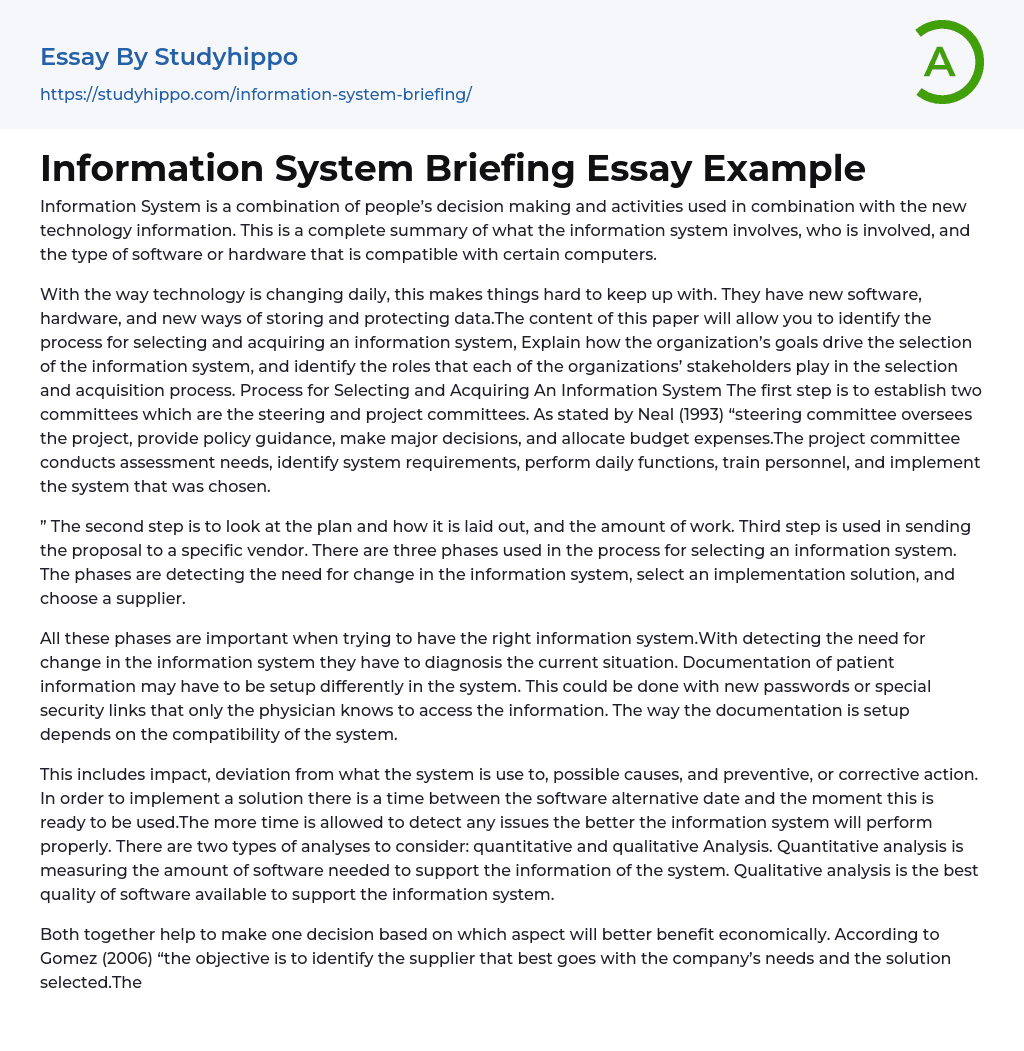The combination of people's decision-making processes and activities with the latest information technology is known as Information System. This includes a thorough understanding of the system components, stakeholders involved, and the necessary software or hardware to operate specific computer systems.
In today's fast-evolving technology landscape, staying current with the latest software, hardware, and data protection techniques can be challenging. The purpose of this article is to provide guidance on selecting and acquiring an information system by explaining the impact of organizational goals on system selection and identifying the different stakeholders involved in the process.
The process starts by forming two committees: a steering committee responsible for overseeing the project, providing policy guidance, making major decisions, and allocating budget expenses; and a project committee tasked with assessing needs, identifying system requirements, performing daily functions, tr
...aining personnel, and implementing the chosen system (Neal, 1993).
"The process for selecting an information system involves three phases. The first phase is detecting the need for change in the current system. The second step involves examining the plan's layout and workload. The third and final phase entails sending the proposal to a specific vendor to select an implementation solution and choose a supplier."
Having the right information system is contingent upon several vital phases. The initial step involves identifying the necessity for transformation within the system and subsequently assessing its current state. Changes in the setup of patient data documentation may be required by implementing new passwords or unique security links restricted only to physicians for access. The compatibility of the system dictates how the documentation is established.
The information system performance can be affected by various factors, such as impact, deviation from the system's norms,
possible causes, and necessary actions for prevention or correction. To implement a solution, there is a timeframe between the alternative software date and its usability. The longer this timeframe, the more efficient the information system will operate due to better issue detection. Two types of analysis must be considered: quantitative and qualitative analysis. The former measures the amount of software required to support the system's information, while the latter evaluates the best quality software for supporting the information system.
The combination of factors aid in determining the most economically beneficial decision. Gomez (2006) states that the main objective is to ascertain the supplier that meets the company's requirements and chosen solution. The key activities encompass a Criteria List, interviews with candidates, and evaluation of candidates. The Criteria List facilitates comparison of various systems as per the organization's necessities.
The Bureau of Labor Statistics (2009) states that selecting the appropriate information system is crucial in ensuring its effective and reliable functioning. This involves using candidate interviews to gather information for evaluation when choosing a system supplier, which can help avoid multiple software development efforts. Implementing technology aligned with organizational goals supports achieving those goals by selecting and configuring compatible hardware and software resulting in new computer systems.
Under the guidance of a planner, Management and Information Technology directors are responsible for ensuring continuity, availability, and security of data services within an organization. During the selection and acquisition process, various stakeholders such as members of the organization, funding agencies, shareholders, suppliers, employees, investors and the local community where the organization operates play critical roles. To ensure mutual trust and respect between these stakeholders it is essential to identify their
unique functions (Commonwealth of Australia 2009).
It is important for members of the organization to interact openly with each other and be visible in the community. Demonstrating progress towards achieving goals is crucial for continued funding. Shareholders are interested in verifying the validity of discussed mergers. Suppliers contribute to the software life cycle and will evaluate quality standards. Ultimately, employees play a critical role in implementing necessary changes.
The aim of this article is to showcase the benefits and potential cost savings that can be achieved by implementing the new information system in an organization. Intermediaries, such as investors, play a vital role among various organizations. Moreover, the community where the organization operates provides valuable support and input when it comes to decision-making processes – including their preferences and knowledge about new technologies. Overall, this article has covered several topics from identifying the process of selecting and acquiring an information system to understanding the significance of stakeholders in this process. This information will help organizations choose suitable software or hardware systems that align with their requirements.
It is important for information systems to remain current, just like how computer software should be updated regularly for daily use.
- Android essays
- Application Software essays
- Benchmark essays
- Computer Network essays
- Computer Programming essays
- Computer Security essays
- Computer Software essays
- Cryptography essays
- Data collection essays
- Data Mining essays
- Graphic Design essays
- Information Systems essays
- Internet essays
- Network Security essays
- Website essays
- World Wide Web essays
- John Locke essays
- 9/11 essays
- A Good Teacher essays
- A Healthy Diet essays
- A Modest Proposal essays
- A&P essays
- Academic Achievement essays
- Achievement essays
- Achieving goals essays
- Admission essays
- Advantages And Disadvantages Of Internet essays
- Alcoholic drinks essays
- Ammonia essays
- Analytical essays
- Ancient Olympic Games essays
- APA essays
- Arabian Peninsula essays
- Argument essays
- Argumentative essays
- Art essays
- Atlantic Ocean essays
- Auto-ethnography essays
- Autobiography essays
- Ballad essays
- Batman essays
- Binge Eating essays
- Black Power Movement essays
- Blogger essays
- Body Mass Index essays
- Book I Want a Wife essays
- Boycott essays
- Breastfeeding essays
- Bulimia Nervosa essays
- Business essays




